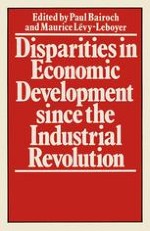
1981 | OriginalPaper | Chapter
Regional Inequalities in Italy
Author : A. Graziani
Published in: Disparities in Economic Development since the Industrial Revolution
Publisher: Palgrave Macmillan UK
Included in: Professional Book Archive
Activate our intelligent search to find suitable subject content or patents.
Select sections of text to find matching patents with Artificial Intelligence. powered by
Select sections of text to find additional relevant content using AI-assisted search. powered by
At the end of the Second World War economic conditions in Southern Italy were extremely precarious. The southern regions were still dominated by agriculture, the agricultural sector being itself extremely unequal and, in general, very poor. All along the coasts one could detect tiny strips of intensively cultivated land, where density of population reached extremely high peaks. But even along the coasts one could find extensive marshes, where pastures, alternated with wheat growing, were the only kind of land use that malaria made possible. In the inner areas, where deforestation had produced an extensive erosion of natural resources, and where property was mainly in the form of big estates, dry crops were the rule. In those areas, small parcels of land were cultivated by peasant families who, not being the owners of the land, were tied to absentee landowners by contracts which were widely different from area to area. Here and there, a few scattered islands of modern industry were also present (such as steel and mechanical industries around Naples, or chemical industries at Crotone). But even such industry as existed was mainly oriented to war production, and it was now necessary to reconvert it to other lines of production in order to make it meet the requirements of the market. The remaining industries of Southern Italy were in the nature of a mix of traditional activities, mainly concentrated in the sectors of food, wood, and clothing.